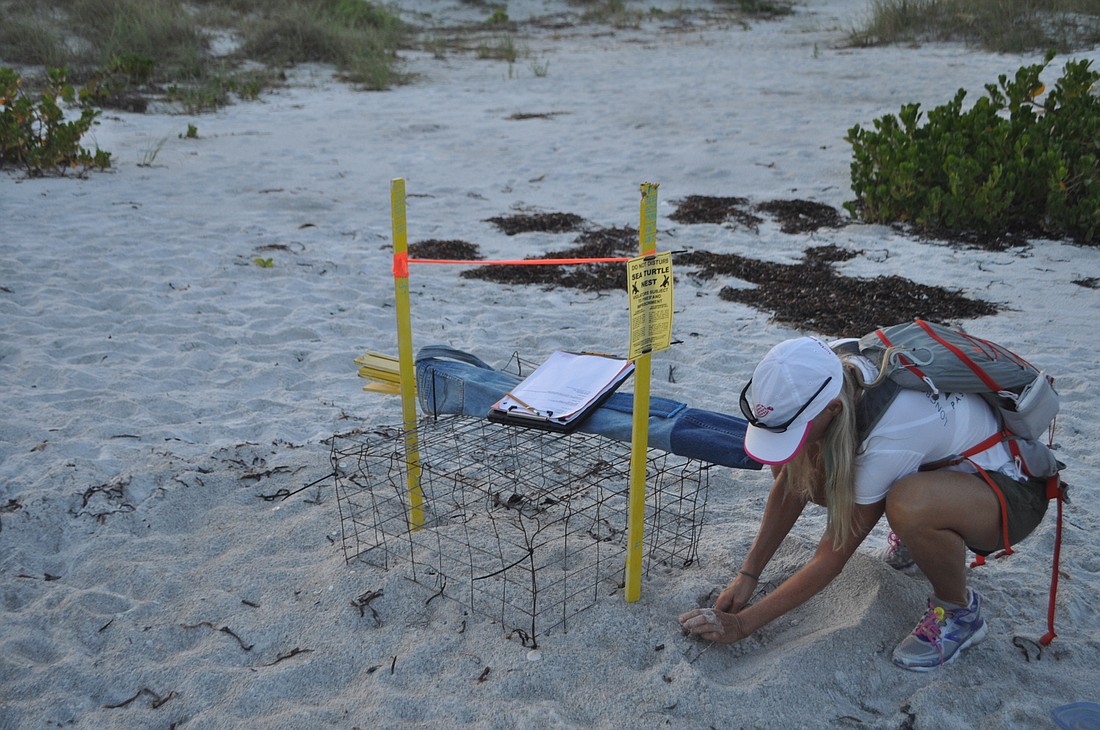- November 14, 2024
-
-
Loading

Loading

And they’re off.
With the recent spotting of two loggerhead sea turtle nests on Longboat Key, it’s safe to say turtle nesting season is underway.
As the flippered animals begin to arrive, the Longboat Key Turtle Watch, along with the town of Longboat Key, are making moves to educate residents and visitors.
The Longboat Key Turtle Watch, in partnership with Ringling College of Art and Design, has created a new awareness campaign with the motto “Flip a Switch, Make a Move.”
Seamon and other Turtle Watch volunteers have distributed the posters to hotels and property managers across both counties of Longboat Key in hopes of reaching visitors and residents for the 2018 nesting season, which runs from May 1 to Oct. 31. Along with posters, volunteers have passed out door hangers as well.
“I think really our mission is to continue to educate best we can and make it fun,” Turtle Watch Vice President Cyndi Seamon said. “We’re really excited about ‘Flip a Switch, Make a Move’ because it’s fun. It looks fun.”
Along with the campaign, the group has been a force in the new turtle-protection rules and enforcement. Seamon said she thinks the citation process has collected “a little more steam.”
Last summer, three turtles became tangled in chairs left overnight on the beach. Although two turtles released themselves, one turtle and chair were never found. Last summer also brought a 207 disorientations, 16 of them adults, compared to 165 the summer before.
“We had a lot of adult disorientations, like more than I’ve ever seen, which to get an adult to disorient takes a lot,” Seamon said. “It doesn’t take a lot to get a little hatchling to go the wrong way.”
Longboat Key Code Enforcement Officer Chris Elbon said this year will bring more options in terms of gaining voluntary compliance with the turtle codes. Last year, the Code Enforcement department noted 19 beach obstructions and 50 cases were opened for lighting violations.
This year, officials have requested code enforcement officers be given the authority to issue citations with monetary fines. With the new system, officers could give a point-in-time citation, which means a violation is happening at that exact moment. Those citations are issued for irreparable or irreversible violations that are transient, Elbon said.
“There would still be some warnings being issued prior to a citation. That’s more of an officer discretion, which I think is reasonable because you have a lot of visitors, so they may not know [the code],” Elbon said. “So, the first is ‘OK, here is a warning. Turn off the light.’ Then the second night, ‘OK, it’s still on,’ and it’s the same visitor or owner and they could receive a citation.”
Aside from the educational campaign and code enforcement, the Turtle Watch will continue its weekly walks in June and July when people can join them in looking for newly laid nests.
The Turtle Watch started walking the beaches on April 15 in case any turtles decided to nest early. No nests were spotted until the morning of April 27.
Last year, turtles that nested on Longboat Key broke the record set in 2016. In 2017, 1,260 loggerhead nests and 17 green sea turtle nests were counted. The total in 2016 was 1,184.
“We don’t really know what to expect,” Mote Marine Laboratory Senior Biologist Melissa Bernhard said. “They have been a little unpredictable, but the numbers have been increasing overall the last 10 or so years, so we’re expecting a good year. We don’t know if that means they’ll be on par with the last couple of years or a record year.”
Mote scientists, Bernhard said, have reason to believe the increase in nesting turtles over the past few years could be the effect of turtles being put on under the Endangered Species Act 30 years ago.
As nests begin to pop up, both Bernhard and Seamon remind people to be wary of how they leave the beach.
“The biggest thing is keeping the beaches as natural as we can, so keeping lights off so the beach stays dark,” she said.
In addition, Bernhard added that filling in any holes and knocking down sandcastles is helpful as they serve as obstacles to turtles. Also, removing furniture, which falls under the town’s ordinance, as one leaves the beach will prevent more obstacles.
And sometimes, help can be off the sand. Seamon said local resorts, such as Zota Beach Resort, are doing what they can to help the environment. Zota, she said, uses environmentally friendly straws.
“Everybody is kind of trying what they can to make a lesser impact,” she said. “We’re all here to enjoy it, but we just need to share it with everybody.”